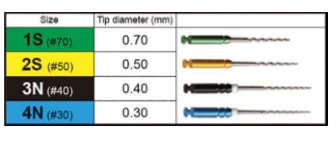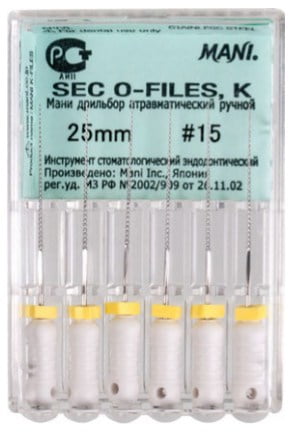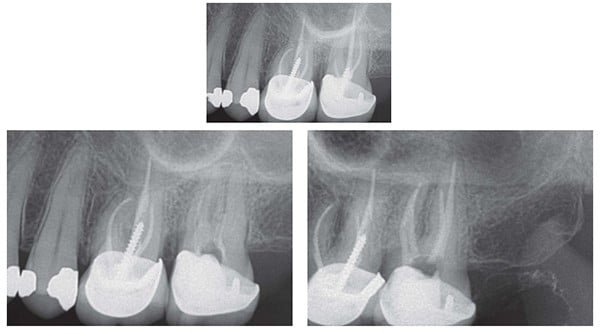Dr. Rich Mounce reviews a technique for removal of GP during endodontic retreatment
Removal of gutta percha (GP) is a critical step in endodontic retreatment. Removal of GP is generally accomplished by the use of heat, Hedstrom files, GP solvents, and rotary GP removal instruments. This column was written to describe the steps commonly used for GP removal in endodontic retreatment with a focus on the Mani GP Removal (GPR) instruments (Figure 1).

Conceptually, assuming the tooth is restorable and retreatment is indicated, the key procedural objectives in retreatment are to atraumatically remove existing GP while simultaneously avoiding canal transportation and/or excessive removal of dentin and achieve patency, followed by completion of the root canal.
Prior to engaging in retreatment, pre-operative radiographs and possibly cone beam images should be carefully evaluated. Radiographic images may or may not reflect the clinical reality. For example, some paste root canals may appear to be GP, and once encountered, such paste root canals may require a completely different set of procedures for predictable removal.
Initially, all defective restorations and caries are removed, straight-line access is obtained, and the coronal GP is uncovered. Generally, as a first step in GP removal, either a heat source such as the Meta Biomed E&Q Master™ heat source is used in a downpacking motion to create a small space for the subsequent use of GPR, or alternatively, a GP removal instrument is used without the aforementioned “heating step.”

If the heat source is inserted first for bulk removal, most commonly, the FM tip (.08 tapered) is used at approximately 200ºC in a 3-second vertical downpack motion. The insertion of the heat tip is passive, never forced, and solvents are not used at this stage in the process.
Whether utilizing heat first or not, the Mani GPR file chosen for bulk GP removal is dependent on the size of the canal being evacuated. Large and relatively straight canals are best evacuated through the use of the 1S and 2S instruments. Alternatively, more narrow and curved canals may require the 3N and 4N instruments.
If the GPR instrument is inserted directly into the GP without the initial use of heat, advancement of the instrument should be slow, deliberate, and if undue resistance is encountered, the apical advancement should be stopped immediately. The foot pedal of the motor is engaged fully so that the maximum rpm is utilized while driving the GPR into the GP. GPR instruments, used appropriately, should move through the GP “like a hot knife through butter” as the rotation of the file both heats the GP and drives the debris coronally. Most commonly, only one GPR insertion is required to remove the bulk of the GP, often leaving only a small amount at the apex which will be removed with solvents and hand files.
If the GPR instrument does not move easily through the GP, the clinician should chose the next smaller GPR instrument, apply heat, and/or perhaps try a slightly higher rpm. It is not advised to take the GPR file to the minor constriction.
The Mani GPR system is a 4-file system that is configured into an assorted pack of 4 instruments (1S, 2S, 3N, 4N) and 4 individual sizes, again, 1S, 2S, 3N, and 4N sizes. The 1 and 2 “S” instruments are stainless steel, and the 3 and 4 “N” instruments are nickel titanium. In order of decreasing tip sizes — the 1S (16 mm, green, .70 mm tip size); 2S (18 mm, yellow, .50 mm tip size); 3N (21 mm, black, .40 mm tip size); and the 4N (21mm, blue, .03 mm tip size) — the files can be used in any sequence desired. Not all GPR files are required for any given canal, and often only one file is needed. All files are teardrop shaped in cross section and .04 tapered. Usually, 1500 rpm is adequate to power the GPR files. In my hands, the most common GPR instrument utilized is the blue 4N No. 30 tip size nickel-titanium instrument.
Once the bulk of the GP has been removed and prior to using solvents to remove GP, it is often advantageous to use H files to remove any significantly sized fragments of remaining GP. Mani H files are available in many varieties for this purpose and include standard stainless steel H files, safe-ended stainless steel H files (SEC O H files), nickel-titanium H files, and/or medium sizes of stainless steel H files (12, 17, 22, 27, etc.). Which of these H files is indicated for treatment is generally a matter of personal preference.
Once the bulk of the GP is removed as previously described, if apical gutta percha remains, pre-curved hand files (Mani SEC O K files safe-ended K files, Mani D Finders, K files, etc.) are used to obtain patency in the presence of a drop of GP solvent (Figures 2-3C).

This article has reviewed the common techniques for removal of GP during endodontic retreatment with a focus on atraumatic removal of GP using heat, Mani GPR files, H files, and solvents with hand files. Emphasis has been placed on removing GP without transporting canals and the vital importance of achieving and maintaining apical patency.
Stay Relevant With Endodontic Practice US
Join our email list for CE courses and webinars, articles and more..


